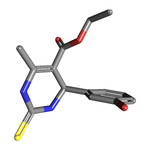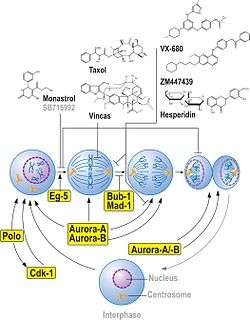Monastrol
 | |
 | |
| Names | |
|---|---|
| IUPAC name
ethyl 4-(3-hydroxyphenyl)-6-methyl-2-sulfanylidene-3,4-dihydro-1H-pyrimidine-5-carboxylate | |
| Other names
Monastrol | |
| Identifiers | |
| 3D model (Jmol) | Interactive image |
| ChEBI | CHEBI:75382 |
| ChEMBL | ChEMBL236789 |
| ChemSpider | 2259791 |
| PubChem | 2987927 |
| |
| |
| Properties | |
| C14H16N2O3S | |
| Molar mass | 292.35344 |
| Except where otherwise noted, data are given for materials in their standard state (at 25 °C [77 °F], 100 kPa). | |
| | |
| Infobox references | |
Monastrol is a cell-permeable small molecule inhibitor discovered by Thomas U. Mayer in the lab of Tim Mitchison. Monastrol was shown to inhibit the kinesin-5 (also known as KIF11, Kinesin Eg5), a motor protein important for spindle bipolarity.[1][2]
Mechanism of action

Monastrol binds to a long loop that is specific to the Eg5 (also known as KIF11 or kinesin-5) kinesin family, and allosterically inhibits ATPase activity of the kinesin [3]
Monastrol is a small, cell-permeable molecule that arrests cells in mitosis by specifically inhibiting Eg5, a member of the Kinesin-5 family. We have used steady-state and presteady-state kinetics as well as equilibrium binding approaches to define the mechanistic basis of S-monastrol inhibition of monomeric human Eg5/KSP. In the absence of microtubules (Mts), the basal ATPase activity is inhibited through slowed product release. In the presence of microtubules, the ATPase activity is also reduced with weakened binding of Eg5 to microtubules during steady-state ATP turnover. Monastrol-treated Eg5 also shows a decreased relative affinity for microtubules under equilibrium conditions. The Mt.Eg5 presteady-state kinetics of ATP binding and the subsequent ATP-dependent isomerization are unaffected during the first ATP turnover. However, monastrol appears to stabilize a conformation that allows for reversals at the ATP hydrolysis step. Monastrol promotes a dramatic decrease in the observed rate of Eg5 association with microtubules, and ADP release is slowed without trapping the Mt.Eg5.ADP intermediate. We propose that S-monastrol binding to Eg5 induces a stable conformational change in the motor domain that favors ATP re-synthesis after ATP hydrolysis. The aberrant interactions with the microtubule and the reversals at the ATP hydrolysis step alter the ability of Eg5 to generate force, thereby yielding a nonproductive Mt.Eg5 complex that cannot establish or maintain the bipolar spindle.
References
- ↑ Thomas U. Mayer; Tarun M. Kapoor; Stephen J. Haggarty; Randall W. King; Stuart L. Schreiber; Timothy J. Mitchison (1999). "Small Molecule Inhibitor of Mitotic Spindle Bipolarity Identified in a Phenotype-Based Screen". Science. 286 (5441): 971–974. doi:10.1126/science.286.5441.971. PMID 10542155.
- ↑ Mayer TU, Kapoor TM, Haggarty SJ, King RW, Schreiber SL, Mitchison TJ (October 1999). "Small molecule inhibitor of mitotic spindle bipolarity identified in a phenotype-based screen". 286 (5441): 971–4. doi:10.1126/science.286.5441.971. PMID 10542155.
- ↑ Maliga Z, Kapoor TM, Mitchison TJ (September 2002). "Evidence that monastrol is an allosteric inhibitor of the mitotic kinesin Eg5". Chem. Biol. 9 (9): 989–96. doi:10.1016/S1074-5521(02)00212-0. PMID 12323373.